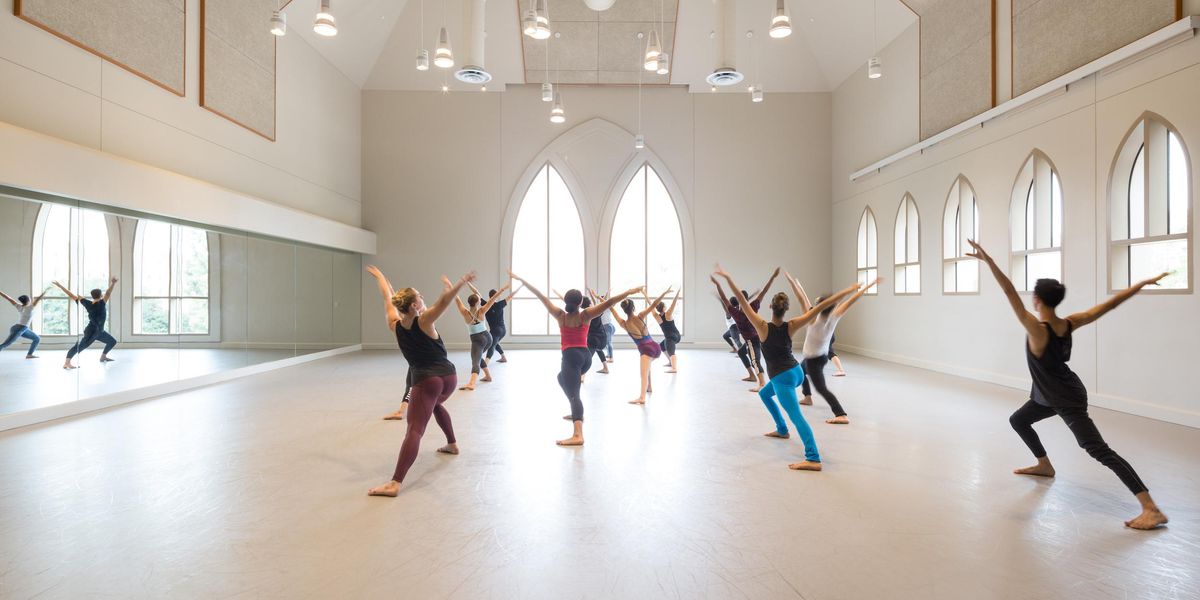On Broadway: Funny Lady
Stroman rehearses ensemble members.
All photos by Paul Kolnik, Courtesy
Bullets.
Little old ladies cutting loose with their walkers in The Producers. A total klutz tangling his arms and legs around the fabulously lithe Girl in a Yellow Dress in Contact. A horde of brides, veils flying, tearing across the stage to catch a husband in New York City Ballet’s Double Feature. It’s hard to think of a big-time choreographer more closely identified with comedy than Susan Stroman.
Even before she directed and choreographed The Producers, Stroman’s wit had flashed through the dances in Crazy for You, Show Boat, The Music Man and Oklahoma!, not to mention pieces the five-time Tony winner made for the Martha Graham Dance Company and NYCB. When she teamed with funnyman Mel Brooks on The Producers, in 2001, it was a match made in farce—and box office—heaven. So for Woody Allen to ask anyone else to direct and choreograph a stage version of his 1994 movie Bullets Over Broadway, or for her to say no, would have been sheer folly.
“The first thing was taking the original screenplay and molding it into the structure for a musical,” Stroman recalls. “For example, in a movie you can go to 50 locations; in a musical, you can only go to about eight. So, taking his different scenes and putting them in new locations, Woody started to write even more scenes, and more jokes. It really allowed him to revisit it and rewrite. After we got the structure, we sat down with a lot of music books all around us, and talked and talked about different songs that could possibly push the plot forward. Because that’s the other thing—if you sing a song, it needs to move the plot forward.”
The Bullets Over Broadway plot, set in 1929, concerns a struggling young playwright, a gangster with a knack for drama and an actress girlfriend, and one of the most delicious divas ever to bite down on a cigarette holder. (Dianne Wiest won an Oscar for her film performance.) And Allen, a clarinetist whose fondness for early jazz is evident not just in his movies but in the Dixieland gigs he’s been playing in New York nightspots for decades, wanted to fill the musical with songs of the period.
“That was a challenge, and I think we cracked it,” Stroman says. When the playwright (played in the musical by Zach Braff) objects to an underhanded suggestion, the gangster explains his moral code with “Tain’t Nobody’s Bizness If I Do”; a dangerous affair begins with “Let’s Misbehave”; and when the gangster’s girl asks him to muscle her into a lead role, he replies with “Gee, Baby, Ain’t I Good to You?”
Stroman has clearly had fun creating jazzy dance to go with this jazzy score. And she found Allen a willing collaborator. At one point, she told him that she wanted to use a Charleston to transition between a nightclub and an alleyway. “He immediately wrote a scene,” she says, and she got her Charleston cue. “It’s a joy to be around people whose minds are always filled with electricity and who are able to fire off jokes and funny thoughts,” she says. “I feel very fortunate that Mel Brooks and Woody Allen both called me.”
From Backstage
Dance captains:
Synthia Link, who was a swing in Stroman’s Big Fish, and Eric Santagata, who assisted Stroman on The Scottsboro Boys.
Associate choreographer:
James Gray, a dance captain on The Producers and Young Frankenstein.
Why they got the jobs:
“I pick dance captains and associates who will not only be there for me with their talent, but who will be there for the company with gracious personalities. It’s important to me who has the authority when I’m not around.”
Dance ensemble:
8 women and 8 men. “The girls play nightclub performers and flappers and a lot of other parts; the guys play gangsters and patrons in the club.”
Specialties:
Tap, Charleston, acrobatics and ballet. “In what I refer to as ‘the gangster ballet,’ the flapper girls go flying through the air in jetés and tours jetés.”
Pre-show warm-up:
“A lot of little variations on Charleston steps, to get them in the ‘20s and in the mood. We do the knock-knees and the windmill, and we do the breakaway Charleston, which is almost swing dancing. And then we do a couple of easy tap steps, like the shim sham.”
Above: Stroman with music supervisor Glen Kelly.




